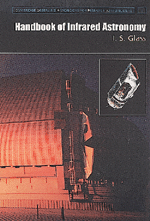Introduction
Published online by Cambridge University Press: 01 October 2009
Summary
More and more investigators are being attracted to work in the infrared spectral region. My intention in this book is to introduce the infrared, its peculiarities and its special techniques, to a new audience that may include established astronomers as well as new students. Basic facts and figures are emphasized and I have not tried to cover all current research. The approach usually avoids the historical and the reader is referred instead to recent books and papers. The origins of ideas are always complex and, with something like 104 papers published, it is impossible to do justice to every individual in the field.
The first chapter deals with the basic facts of blackbody radiation, which plays a dominant role in infrared astronomy. A short review of atomic and molecular physics follows in order to provide a convenient reminder of the meaning of spectroscopic nomenclature. The second chapter covers the general properties of the Earth's atmosphere and outlines the main infrared surveys that have taken place or will shortly do so. Chapter 3 is devoted to photometry, emphasizing its fundamental aspects and the importance of traceability and calibration. Chapter 4 is an introduction to spectroscopy, treating firstly the stars. Photodissociation regions, which are of great interest in the infrared and millimeter region, are followed by HII regions and some “Rosetta Stone” spectra of representative objects. Chapter 5 is devoted to dust and its central role in star formation. Finally, because an understanding of the technology is important in obtaining reliable results, the last chapter covers the basics of infrared instrumentation.
- Type
- Chapter
- Information
- Handbook of Infrared Astronomy , pp. 1 - 4Publisher: Cambridge University PressPrint publication year: 1999
- 1
- Cited by

